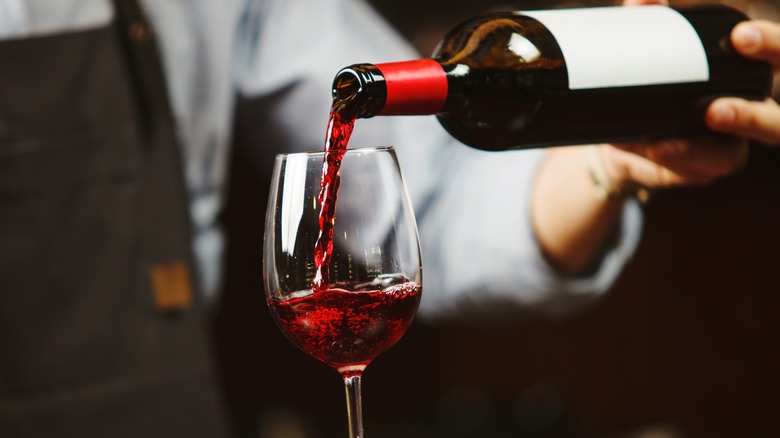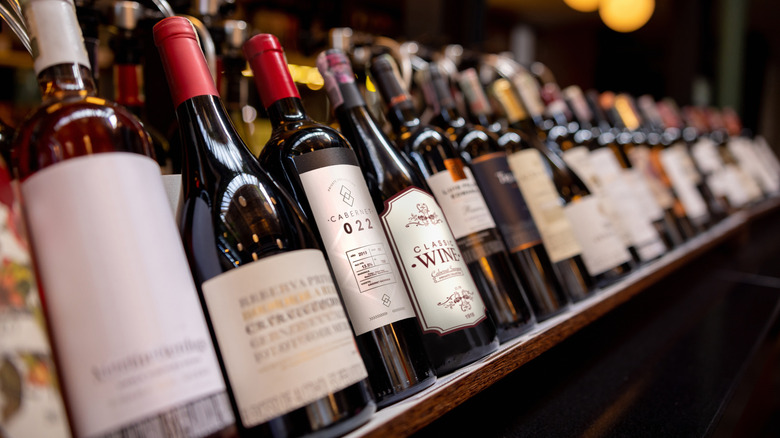The Myth About Restaurant Wine Markups You Should Un-Learn
Wine can get expensive. Unless you're drinking more affordable red wine blends or bottom-shelf bottles, a fancy glass or bottle of wine can come with a hefty price tag if you order it at a restaurant. It often feels like price gouging, but is it? Do restaurants charge what seems like three or four times the wine's cost just to make extra profits?
For answers, we spoke with Doreen Winkler, founder of Orange Glou, the world's only wine store and subscription service dedicated to orange wines. According to Winkler, the idea of maliciously high markups tends to be exaggerated. "Contrary to popular belief, markups are not simply three or four times the cost price," she said. "Pricing is determined by a mix of costs and profits, and it varies based on factors such as the restaurant's location. For example, an expensive location in Manhattan, a seasonal restaurant in the Hamptons, or a suburban area in the Midwest will have different pricing strategies."
This isn't to say that restaurants don't mark up their wine, because it is more expensive to buy wine at a restaurant than at a corner liquor store. However, it's not usually simple greed — it involves strategies for covering costs.
How restaurants determine wine prices
A restaurant's wine pricing depends on its business model (casual versus formal), its location, and expenses like staff wages and rent. Often, there are both state and federal taxes that apply for the wine to be shipped from the vineyard or winery to the wholesaler and eventually to the restaurant — then you buy the wine to sip with your brunch, which comes with sales taxes depending on your city or state.
Many restaurants use the industry standard markup of somewhere between 200-300% for their wines. Other restaurants employ a sliding scale for wine markups, which means cheaper wines have higher markups than more expensive wines. For example, a $20 wine bottle is marked up 250% to $50, but a $70 bottle is marked up 200% to $140. Extremely rare wines might have way higher markups, but not your simple glass of Pinot Grigio.
According to Winkler, restaurants know better than to go overboard with pricing. "It's important to understand that the business must cover its costs to continue serving customers," she said. "There is no straightforward way for a customer to know a wine's cost, but understanding these factors can provide insight into whether a wine's price is reasonable."
How to find reasonably priced wines
It's helpful to know the behind-the-scenes math of wine pricing, but as a customer, your goal is to buy something nice without getting swindled. There are some tips to keep in mind here. It's commonly stated that restaurants increase the price of the second-cheapest wine on their menu because customers who don't wish to look cheap will often order it; there's debate over how common this is, but that customer mindset is a real phenomenon, so be wary. Mid-range wines can be a safe spot where they're marked up less without costing too much. If the restaurant has a "house wine," it often has a massive markup and it's usually licensed from an outside winery anyway.
It's true that some restaurants sell a glass of wine for as much money as a full bottle costs in retail, but it's not always such a cut-and-dry surcharge. That higher cost won't translate fully into oversized profits for the restaurant; it happens because there are extra steps for the wine to reach the restaurant, which all cost money. It's also no excuse to avoid tipping your server when they hand you the bill.


